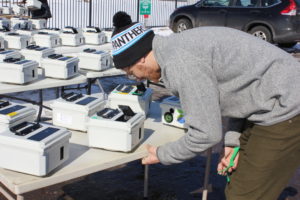Engineering Source occasionally features exciting new research, publications or grants in the Walter Scott, Jr. College of Engineering, which produces nearly $88 million of the university’s $450 million in annual research.
What’s the research?

U.S. schools located in impoverished areas or districts that represent historically underserved students are more likely to suffer from poor air quality, a team at Colorado State University’s Department of Atmospheric Science has found.
This research appeared in the fall in GeoHealth, the American Geophysical Union’s research journal that marries human and planetary health for a sustainable future.
Who is involved, and what’s the big takeaway?
Led by Professor Jeff Pierce, scientists studying K-12 public school databases found major socioeconomic disparities related to healthy air around schools. The team studied two kinds of pollutants: fine particulate matter and nitrogen dioxide or NO2 that largely originates from dirty combustion such as wildfire smoke and cars.
Fine particulate matter that can easily sneak into lungs is the leading cause of premature death worldwide, according to the World Health Organization.
The team reviewed 2019 demographic and financial information for 98,537 public schools in the contiguous United States through the National Center for Education Statistics. NASA also contributed satellite data with estimates of pollutant concentrations across the country.
Among the findings were that white students attend schools with the lowest concentrations of NO2 followed closely by American Indian/Alaska Native students. Conversely, students from other marginalized groups including Black or African Americans, Asian or Asian/Pacific Islanders, and Hispanics attend schools with relatively higher concentrations of NO2.
Research partners:
Partners included social and health scientists as well as atmospheric scientists and engineers. Contributors included NASA’s Health and Air Quality Applied Sciences Team, Environment and Climate Change Canada, George Washington University, Washington University in St. Louis.
Other CSU researchers involved:
- Atmospheric Science – Emily Fischer, associate professor; Bonne Ford, research scientist; Michael Cheeseman, a doctoral student
- Mechanical Engineering – John Volckens, professor
- Environmental and Radiological Health Sciences – Sheryl Magzamen, associate professor
What’s next?
This data can help communities think about school placement going forward, Pierce said. “Giving schools a focus can help people think about how schools are built,” he said. “Choices can be made so schools aren’t as close to interstate highways or factories.”
These kind of complex issues are going to increasingly require a team in key disciplines like social sciences, health and engineering working together, he added.
“At CSU, we have a critical mass of people thinking about air pollution, from people who have a physical, chemical understanding to those thinking about environmental justice and different ways to slice the data.”
Read more about the research featured by the American Geophysical Union.